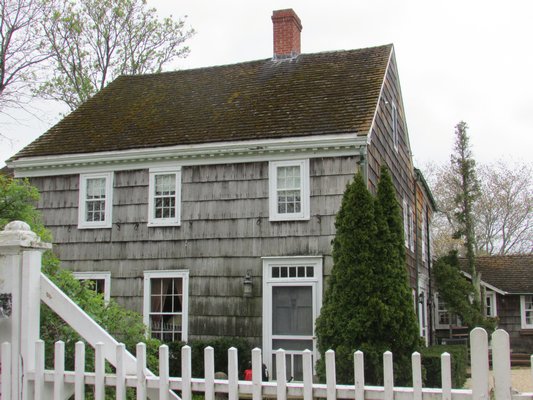
For a number of local residents as well as visitors to the Water Mill Museum, a forthcoming exhibit, “A Home, A Heart: Rediscovering the Historical Houses of Water Mill,” may well be not a “rediscovering” so much as a find.The hamlet, the only one on the East End to be named for a major historical feature, tends to be tucked away in the popular mind as a charming though not historically distinctive bit of Southampton Town Americana. The exhibit should make a difference and inspire interest in what Megan Flynn, the exhibit’s curator, notes is special, starting with a blue historic marker opposite the museum: “First Water Mill 1644 Built by Edward Howell near this site for Southampton Colony.”
Howell came to the area in the 1640s from Lynn, Massachusetts, where he had owned a water mill on a pond, and before that, from England, where he was lord of his manor and thus a wealthy man. The mill he built in Water Mill four years after the Southampton Colony was established was the only such mill in the area, all others operating on wind power. The advantage was that the mill could grind grain when there was no wind.
Over the decades, various families owned the mill, using water power to weave cloth and manufacture paper and building homes around the mill. In time, the building fell on hard times, and only in the mid-20th century, when the Ladies Auxiliary of Water Mill took ownership, did the mill become part of a restoration and reconstruction project and see life again as a water-powered grist mill.
The exhibit consists of four panels of charts, photography and texts as well as an optional self-directed driving tour of eight historic residences. What distinguishes the exhibit, Ms. Flynn says, is that it shows “the houses as physical relics of different historical moments in Water Mill’s past,” notably the Halsey-Foster house on Head of Pond Road, undergoing renovations since this past spring, which was built in 1775, the year the War for Independence began.
The exhibit also reveals some little-known tidbits, including the fact that Asher Benedict, who owned the miller’s house next to the museum, sued the Long Island Rail Road in 1870 because the culvert laid under the track was so small it restricted the flow of water to the mill. He won, after five years, being awarded $350 in damages and having a new culvert put in. (An interesting side note is that during the litigation period, a windmill was attached to the roof of the house to increase power.)
Though the driving tour is of exteriors only, viewers will have an opportunity to view major architectural styles: Georgian Colonial (early to mid-1700s), Federal or Roman (1780s to 1820s), Greek Revival (early 19th century) and Colonial Revival (late-19th to mid-20th century), not to mention Shingle-Style architecture, popular especially from 1890 to1900, and seen particularly in the Corwith-Jennings house.
Shingle was “a far cry from the Colonial and Federal-style farmhouses from the 18th and early 19th centuries,” Ms. Flynn says, and was “self-consciously designed not to be `mainstream.’” It thus represents “a very high style seen only in resort towns like Newport or the Hamptons,” and serves as a reflection of Water Mill’s changing fortunes over the course of the 19th and into the 20th century.
Not incidentally, Ms. Flynn points out, another major purpose of the exhibit is “to showcase the historic black-and-white photographs from 1900.” The exhibit has been so designed, however, that it’s not necessary to take the tour because, Ms. Flynn used “a color-coding system” to link the historic photographs to modern photographs she herself took of each house, “supplementing them with images from the internet, making it possible to see how each house looks now.”
This is an important exhibit, the museum’s archivist and town historian, Marlene Haresign, emphasized in a phone interview, because it “calls attention to the enormous number of historical farmhouses and other buildings in Water Mill that are still in their original agricultural settings, though increasingly overwhelmed by nearby McMansions.”
Ms. Haresign notes that only three buildings in Water Mill have been landmarked, at the urging of Southampton Town’s Landmarks & Historic Districts Board chairwoman, Sally Spanburgh. However, she said she hopes many more of the 100-plus identified as historically significant by a commissioned study several years ago will find owners eager to celebrate history.
The exhibit, made possible by a grant from the Town of Southampton Cultural Arts Program and donations from museum members, opens on Thursday, May 26, and will run through October 10. Hours are Thursdays through Mondays from 11a.m. to 5 p.m. Admission is free. A reception will take place at the museum on Saturday, June 4, from 5 to 7 p.m. For further information visit www.watermillmuseum.org or call (631) 726-4625.